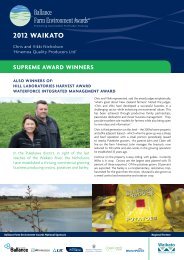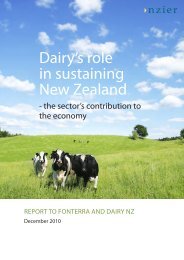NZIER report on compensation for transmission infrastructure
NZIER report on compensation for transmission infrastructure
NZIER report on compensation for transmission infrastructure
You also want an ePaper? Increase the reach of your titles
YUMPU automatically turns print PDFs into web optimized ePapers that Google loves.
4.1.1 Market value of land<br />
Estimati<strong>on</strong>s of land market value have a degree of inaccuracy. Although land market<br />
value at a point in time theoretically reflects all possible future uses, there are limited<br />
open market land sales data to base values <strong>on</strong> and these data are not necessarily<br />
locati<strong>on</strong> specific. Some authors suggest adjusting market value to allow <strong>for</strong> potential<br />
future uses of each easement. This risks increasing inaccuracy, however. Estimating<br />
and valuing possible uses and then adding this amount to land market prices risks<br />
double counting price determinants (as these factors may have already been<br />
included in land market price).<br />
To some extent the issue of inaccurate land price data may be addressed by<br />
providing part of compensati<strong>on</strong> periodically with opti<strong>on</strong>s <strong>for</strong> rental amounts to be<br />
adjusted.<br />
At the time of creati<strong>on</strong> of an easement, however, <strong>for</strong> want of a better alternative, land<br />
price should be based <strong>on</strong> the market value of the best possible use of the land. The<br />
most appropriate market data should be used, with c<strong>on</strong>siderati<strong>on</strong> given to the<br />
locati<strong>on</strong> specific factors of the easement area. This approach is in agreement with<br />
Cright<strong>on</strong> (2008).<br />
4.1.2 Easement area<br />
As discussed in the literature review the area of the easement can be separated into<br />
land used exclusively by the utility and land still able to be used by the landowner.<br />
The standard approach is <strong>for</strong> land used exclusively by the utility, such as under and<br />
within a close radius of transmissi<strong>on</strong> support structures, to be compensated at 100<br />
percent of its market value. This is logical and appears to be standard practice in<br />
New Zealand (Cright<strong>on</strong> 2008).<br />
The rest of the easement area is generally valued based <strong>on</strong> its productive worth to<br />
the landowner <strong>on</strong>ce the <strong>infrastructure</strong> has been built and, as such, is more open to<br />
debate. Easements impose greater costs <strong>on</strong> <strong>for</strong>estry owners, <strong>for</strong> example, as n<strong>on</strong>e of<br />
the land under lines can be used <strong>for</strong> growing trees. Sheep farmers, <strong>on</strong> the other<br />
hand, use the land under easements in much the same manner as surrounding land.<br />
Forestry should be compensated at 100 percent of the land market value <strong>for</strong> the<br />
whole easement area. The easement area should include the land that the first row<br />
of trees are grown <strong>on</strong> beside the easement, as these trees bend towards sunlight<br />
and are not good <strong>for</strong> timber.<br />
Our understanding is that the main c<strong>on</strong>cern facing <strong>for</strong>estry owners is their liability <strong>for</strong><br />
damage to Transpower <strong>infrastructure</strong> <strong>on</strong> their land from, <strong>for</strong> example, falling trees<br />
damaging structures or lines. This could, to some extent, be addressed by<br />
Transpower widening the easement corridor to minimise the possibility of damage<br />
from trees. The required width <strong>for</strong> <strong>for</strong>estry easements needs to not <strong>on</strong>ly ensure<br />
mature trees are not able to c<strong>on</strong>tact <strong>infrastructure</strong> or lines, but should be wide<br />
<str<strong>on</strong>g>NZIER</str<strong>on</strong>g> – Compensati<strong>on</strong> <strong>for</strong> transmissi<strong>on</strong> <strong>infrastructure</strong> 30
















